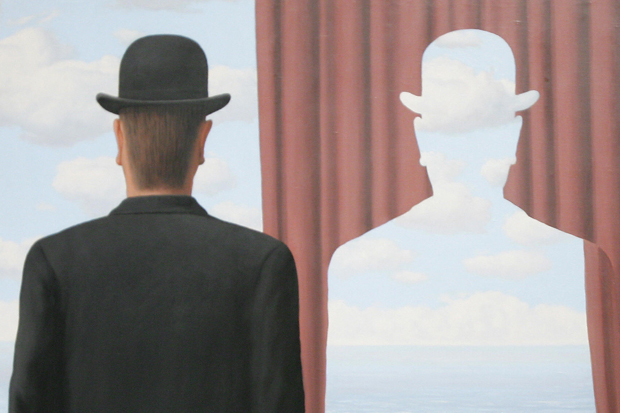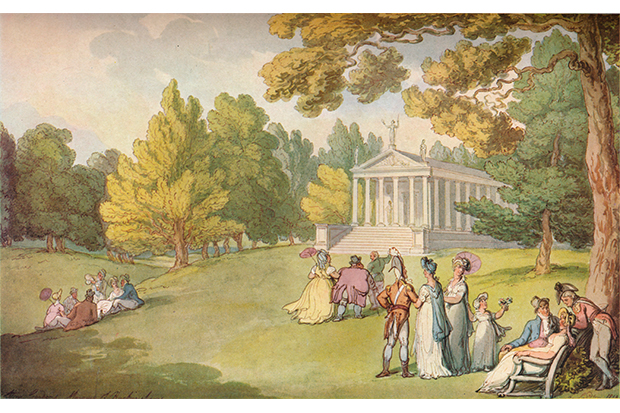Surrealism was, at least initially, as much about writing as painting. A plaque on the Hotel des Grands Hommes in Paris’s Place du Pantheon records that the oneiric movement began in 1919 when André Breton and Philippe Soupault invented ‘l’ecriture automatique’ at numéro 17. Automatic writing, with consciousness suspended, was supposed to open a conduit to an internal dreamworld.
René Magritte (1898–1967) became one of the most famous Surrealist painters, but he wrote throughout his life: detective stories, manifestoes, criticism, essays, prose-poems, lectures, surreal bric-a-brac. His Ecrits Complets was published by Flammarion in 1979 and ran to 764 pages. The avant-garde publisher John Calder intended an English edition, but it never appeared. Calder’s successors have now, happily, published the (more compact) present volume.
More so than many artists, Magritte was shaped by his circumstances. He was born in nondescript Lessines in western Belgium, where the opening of the post office in 1830 was a signal event in the town’s history. Before she married, his mother was a milliner, and hats (symbols of power and authority) are recurrent motifs in his pictures. She killed herself by jumping into the Sambre, a tributary of the Meuse.
So mediocre was Magritte’s upbringing that his mother did not even choose a major river for her suicide. It is said the 14-year-old Magritte saw her recovered body: naked except for its face, obscured by her dress. So here was the source of another recurrent motif in his art: a face that is missing, a face that is replaced by an apple, or breasts and pubic mound which, in ‘Le Viol’ (‘The Rape’), are translated into a face. A preparatory drawing of ‘The Rape’ appeared on the cover of Breton’s manifesto Qu’est-ce que le surrealisme? of 1934.
The shrieking horror of a small, quiet town with its lower middle-class psychoses was Magritte’s Eden. Yet it is wrong to think of Belgium as a source of non-entities. On the contrary, Belgium has, besides surrealists, produced very fine romans policiers, superb beer, world-class chips, chocolate and, latterly, a noteworthy number of expert paedophiles. In 2005 the Flemish De Grootse Belg media poll did not include Magritte in its top ten, but the Francophone equivalent, Les Plus Grandes Belges, had him at number nine, between Hergé at eight and Simenon at ten. Jacques Brel came top.
Surrealism has many associations with this country and one of the gems included here is a facsimile of Magritte’s text for a demonstration at the Young Belgian Artists exhibition at the London Gallery in 1937. This was the year following the original surrealist exhibition at the New Burlington Galleries where Salvador Dalí, holding two dogs on leashes, lectured in a diving-suit and nearly asphyxiated, a condition doubtless giving rise to delirious surreal visions.
In 1937, Magritte was the guest of Edward James, Dali’s patron. The text of his planned ‘demonstration’ at the gallery, originally in French, is the best insight to his art. ‘A real object can replace a word,’ he writes and explains it with ‘The bread of crime’. And ‘The door may open onto an upside-down landscape.’ Certain images, Magritte explains, have a ‘secret affinity’. He says we ‘know the bird in the cage’, but adds that ‘It is more interesting to replace the bird with a fish, or a shoe.’ His art involved the disruption of the space between words and pictures.
Magritte thought of himself as a secret agent and the Selected Writings are his cypher-books. He was happy for his pictures to be known in reproduction because ‘you don’t need to see a writer’s manuscript to be interested in his book’, an aphorism betraying his own literary bias.
The jacket of this fine little volume shows ‘Le Fils d’Homme’ of 1964 : a bowler-hatted self-portrait with a bright green and very sinister Granny Smith apple floating before his face. In one of the prose-poems reproduced here we learn that ‘mystery is what is absolutely necessary in order for reality to exist’. These things you perhaps learn in Lessines. How very weird ordinary things can become!
Selected Writings is nicely presented, properly scholarly and dense with interest. It is good value too. Of course, as a collection covering more than 40 years, it is inevitably repetitive and fragmentary, but there is an irrefragable sense of intellectual and artistic quality throughout. However, it’s a shame there are no illustrations, because Magritte’s art depends on the interaction, real or imagined, forgotten or recalled, of image and word: ‘Ceci n’est pas une pipe’ (‘This is Not a Pipe’) was not only his most famous saying, it was his most famous picture.
The post The faceless man in the bowler hat appeared first on The Spectator.
Got something to add? Join the discussion and comment below.
Get 10 issues for just $10
Subscribe to The Spectator Australia today for the next 10 magazine issues, plus full online access, for just $10.
You might disagree with half of it, but you’ll enjoy reading all of it. Try your first month for free, then just $2 a week for the remainder of your first year.














Comments
Don't miss out
Join the conversation with other Spectator Australia readers. Subscribe to leave a comment.
SUBSCRIBEAlready a subscriber? Log in